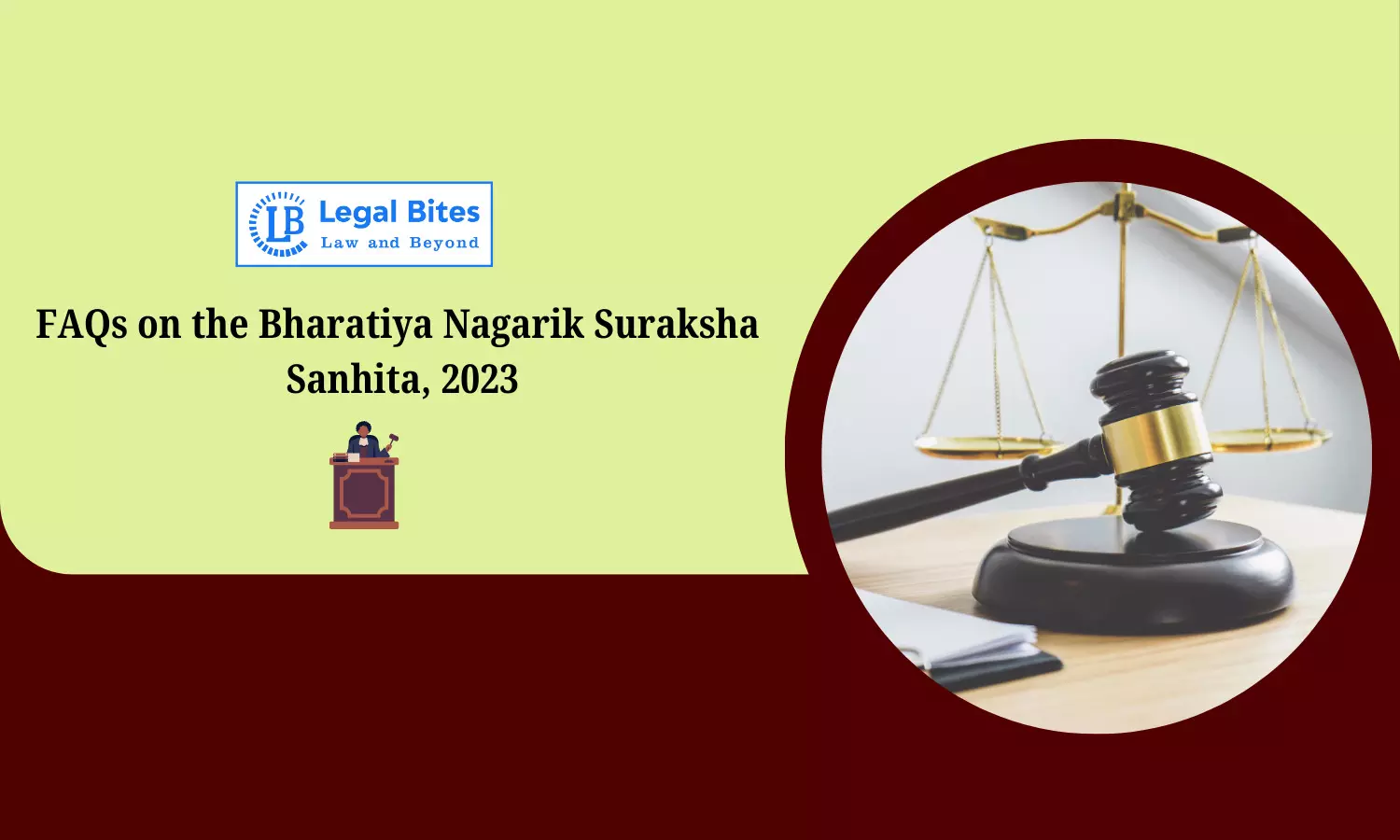FAQs on the Bharatiya Nagarik Suraksha Sanhita, 2023
Get clarity on the Bharatiya Nagarik Suraksha Sanhita, 2023 with these FAQs—your quick guide to India’s reformed procedural law.

Get quick answers! FAQs on the Bharatiya Nagarik Suraksha Sanhita (BNSS), 2023. Clarify your doubts and grasp the procedural reforms in India’s new criminal justice system.
FAQs on the Bharatiya Nagarik Suraksha Sanhita, 2023
1) What is the Bharatiya Nagarik Suraksha Sanhita (BNSS), 2023?
Answer: The BNSS is a comprehensive legislation enacted to replace the CrPC, aiming to modernize India's criminal justice system by incorporating technological advancements, streamlining procedures, and enhancing citizen rights.
2) When did the BNSS come into effect?
Answer: The BNSS was enacted on December 25, 2023, and came into force on July 1, 2024.
3) What are the permitted modes for giving information about a cognizable offence under Section 173(1) BNSS?
Answer: Information can be given either orally or by electronic communication.
4) Is the informant entitled to a copy of the FIR?
Answer: Yes. Section 173(2) mandates that a free copy of the FIR be given to the informant.
5) What is a Zero FIR?
Answer: A Zero FIR is registered at any police station irrespective of jurisdiction and is later transferred to the appropriate jurisdictional police station.
6) Can new facts justify a second FIR as per State of Rajasthan v. Surendra Singh Rathore (2025)?
Answer: Yes, if new facts emerge after the first FIR that show independent criminal acts, a separate FIR is valid and necessary for proper investigation.
7) When is a second FIR not allowed under Surendra Singh Rathore (2025) and earlier rulings?
Answer: A second FIR is not allowed when:
- It is for reinvestigating the same allegations,
- It merely expands on the first FIR,
- The facts were already part of the first investigation and should be included via a supplementary report under Section 193(9) BNSS.
8) What does Section 193 of BNSS, 2023 state?
Answer: It deals with the report of police upon completion of investigation, akin to Section 173 CrPC, covering both charge sheets and closure reports.
9) What is the time limit for completing an investigation under Section 193(2) of BNSS, 2023?
Answer: As per Section 193(2) of the BNSS, the investigation must be completed within two months from the date on which the officer in charge of the police station first records the information relating to the offence
10) What type of deaths are covered under Section 194(1) BNSS?
Answer: Suicides, killings by others, animal attacks, machinery or accidental deaths, and deaths under suspicious circumstances.
11) What does Section 6 of BNSS provide?
Answer: It classifies criminal courts into four types—Courts of Session, Judicial Magistrates of First Class, Judicial Magistrates of Second Class, and Executive Magistrates.
12) Which section deals with territorial divisions of criminal courts?
Answer: Section 7 of BNSS provides for the territorial setup of sessions divisions, and districts.
13) What is the distinction between Judicial and Executive Magistrates?
Answer: Judicial Magistrates conduct trials and pass judgments, while Executive Magistrates focus on administrative and preventive powers.
14) Which section of BNSS defines the contents of a charge?
Answer: Section 234 of the BNSS prescribes what a charge must contain.
14) Does the court have the power to amend charges during the trial?
Answer: Yes, under Section 239 of BNSS, the court can alter or add charges before judgment is pronounced.
15) Is there a prescribed language in which a charge must be written?
Answer: Yes, as per Section 234(6) of BNSS, the charge should be written in the language of the court.
16) Which provision in BNSS deals with plea bargaining?
Answer: Sections 289 to 300 under Chapter XXIII of the Bharatiya Nagarik Suraksha Sanhita, 2023 comprehensively govern the legal framework of plea bargaining in India.
17) What is the time limit to file a plea bargaining application under BNSS?
Answer: It must be filed within 30 days of the framing of charges.
18) Under which section of BNSS was bail sought in Muhammad Jamil v. State of Haryana (2025)?
Answer: Bail was sought under Section 483 of the Bharatiya Nagarik Suraksha Sanhita, 2023.
19) What broader legal principle was reinforced in Muhammad Jamil v. State of Haryana (2025)?
Answer: The case reaffirmed that the right to bail and a speedy trial are integral to personal liberty under Article 21.
20) Who can claim maintenance under BNSS?
Answer: A wife, legitimate or illegitimate child (minor or unable to maintain themselves), and parents can claim maintenance under BNSS.
21) Is Section 125 CrPC now replaced in BNSS?
Answer: Yes, Section 144 of BNSS, 2023 corresponds to Section 125 of CrPC, 1973, governing maintenance claims.

